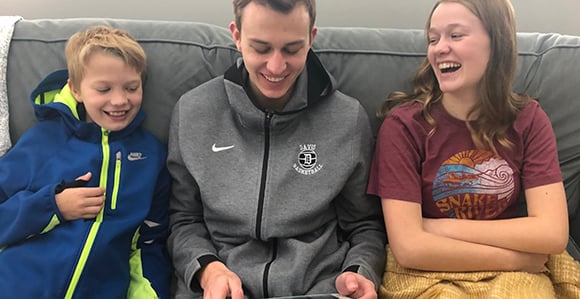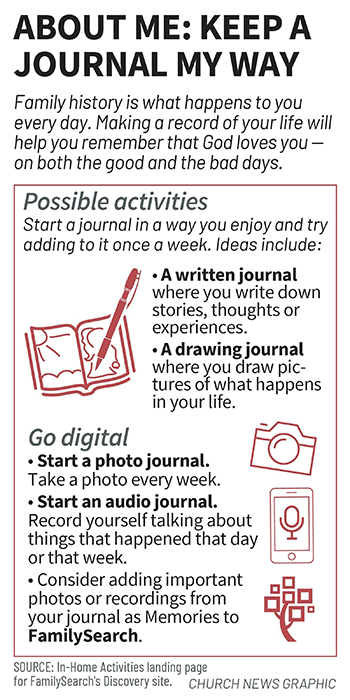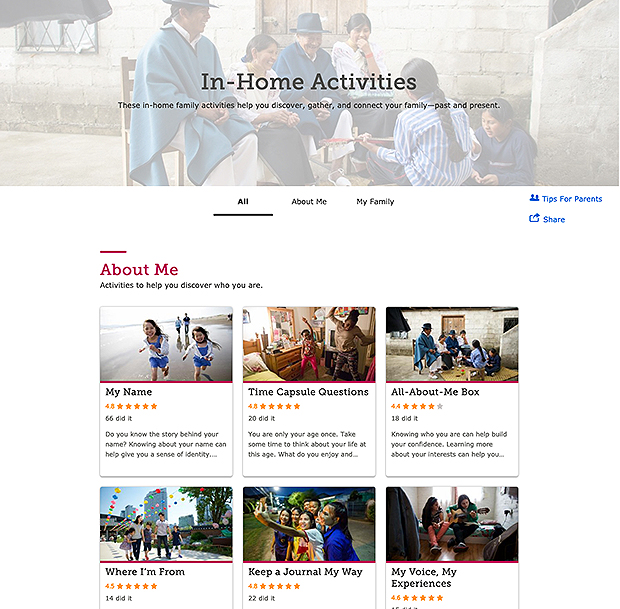Get Your Kids Excited about Family History by Exploring These New In-Home Activities on FamilySearch
Contributed By Scott Taylor, Church News managing editor

Thomas, Sam, and Grace Arrington from Farmington, Utah, share a laugh while using the “Walk Where They Walked” in-home activity on FamilySearch. The new in-home activities on FamilySearch are designed to help get youth and children involved with family history work.
Article Highlights
- FamilySearch’s new in-home activities help engage younger members with family history.
- The activities are available in 10 different languages and across three different categories.
- Families will be strengthened as they participate in family history work.
“Our effort is not to compel everyone to do everything, but encourage everyone to do something.” —President Dallin H. Oaks
Related Links
The three Arrington siblings—Sam, age 18; Grace, 14; and Thomas, 10—were learning about their great-great-great-grandparents from Italy and their great-great-grandparents from the Netherlands through conversations with their parents, Brandon and Emily. Then, using the Google Earth program, the family was digitally transported to Vialfré, Italy, and Delfzyl, Netherlands.
And with the Street View feature, the family was doing virtual walk-throughs of the Italian village and the Dutch town, seeing historic structures still standing today. “Your ancestors walked on these same streets—right past this church,” Emily Arrington told them. “This is where they lived.”
The Arringtons were testing a new FamilySearch discovery activity called “Walk Where They Walked,” one of nearly three dozen such activities helping individuals—particularly children and youth—get their first taste of simple yet engaging family history efforts.
“There’s such a power in connecting with the past,” said Emily Arrington of the Orchard Ward in the Farmington Utah Oakridge Stake. “It’s really bringing our family into family history.”
The “in-home activities”
After several years of preparation and testing, FamilySearch’s “In-Home Activities”—divided into three sections—is online and available for individuals and families to discover who they are and how they fit with their family, both present and past.
“About Me” is a personal discovery about one’s self, with the 11 activities including “Where I’m From,” “The Year I Was Born,” “All-About-Me Box,” and “Remembering My Photos.”
“My Family” extends the discovery to living family members and deceased ancestors, with its 15 activities including “Family Traditions,” “Fill In The Blanks,” “Family Collections,” and “Touch What They Touched.”
“The Temple” helps link family history efforts in gathering together families with preparations for temple attendance and ordinances. Its activities include “Visit the Temple,” “Plan It!” “Be Baptized for an Ancestor,” and “Remembering My Temple Experience.”
“These are easy and natural opportunities for children to have their first experience with family history in a fun and interactive way,” said Sister Joy D. Jones, Primary General President. “What a wonderful opportunity to draw families together, to get to know each other better, and to cherish family ties on both sides of the veil. These activities can deepen understanding of eternal identity and the promised blessings of power and protection as families’ hearts are turned to one another.”
Activities start in technology-free fashion through simple writing, drawing, conversing, and collecting efforts. Digital involvement includes taking or storing photographs, doing audio or video recording, or using computers, smartphones, and online resources.

“We give some technology options,” said Mike Sandberg, a FamilySearch senior product manager, “but we always start with conversations.”
Younger children tend to be drawn more to the “About Me” activities—looking at and talking about themselves and seeing how they fit into family timelines, experiences, and photos.
Older children and teenagers more readily grasp the “My Family” activities and the opportunities to connect with their heritage. They’re more apt to handle the advanced technological and digital options for activities.
Testing was done first with focus groups within the United States, following by an international expansion. For some test groups where economic limitations precluded online capabilities, printed materials were used by parents and children to read and carry out activity descriptions.
Wendy Smedley, FamilySearch marketing director, witnessed several families in Chile—living in humble conditions—connect, laugh, and engage in the simple family history efforts. “It brought a positive spirit into the homes,” she said, adding that involvement in the in-home activities “sparks joy and reminds people of the beauty of the family.”
Upwards of 100 families across the globe tested the activities, which also can be shared via email and several social media platforms. Available in 10 languages, the activities can be accessed online via desktop computers, tablets, and mobile devices, with plans to make PDF versions available.
“About Me” and “My Family” activities do not require a FamilySearch logon; for the “The Temple” activities, one needs to be a member and to have a logon.
Realizing prophetic teachings
The “In-Home Activities” help realize the encouragement of Church leaders for families, children, and youth to be involved in family history and temple efforts.
President Dallin H. Oaks, First Counselor in the First Presidency, underscored the opportunities at home. In a June 1989 Ensign article, then-Elder Oaks wrote: “At home we can keep our journals and gather pictures and data for the books of remembrances of our family members. We can gather and record information available through living relatives. We can write family histories and share their great lessons with our children. … Our effort is not to compel everyone to do everything, but encourage everyone to do something” (“Family History: ‘In Wisdom and Order’”).
And Elder Dale G. Renlund of the Quorum of the Twelve Apostles, speaking in the 2018 RootsTech leadership session, called on those “new and tender in the gospel”—including new converts and 11- and 12-year-old youth to find ways to be focused on family history efforts.
“More will remain active,” he said, “more will be protected as the storms and fierce winds strike.”
He added: “We invite all new converts and new 12-year-olds to discover and gather their families and become active participants in the plan of salvation. We desire to involve 11-year-old children and even younger children in family history work and encourage them to qualify for a limited-use temple recommend when they turn 12 years old.”
Those ages have been amended by the December 2018 announcement now allowing children to obtain a limited-use temple recommend beginning in January of the year they turn 12.
Elder Renlund promised that involvement by those “new and tender” individuals would have a “halo effect” on all those who help. “Faith in the Savior of family and friends who help will increase,” he said.
“The payday”
The Arringtons’ “Walk Where They Walked” experience happened some six months ago. But earlier this month, Emily Arrington’s parents were over for dinner, and 18-year-old Sam enthusiastically recounted to them all about the family’s Google Earth visits to and the Street View walk-throughs of Vialfré and Delfzyl.
Listening to her son Sam share insights about his ancestors over dinner with his grandparents was a welcome reward for the family’s time spent testing the activities and initiating conversations.
“That,” she said, “was like the payday.”

FamilySearch's landing page for desktop users looking for “About Me” and “My Family” in-home activities to help children and youth participate in family history activities. CREDIT-Intellectual Reserve, Inc.
